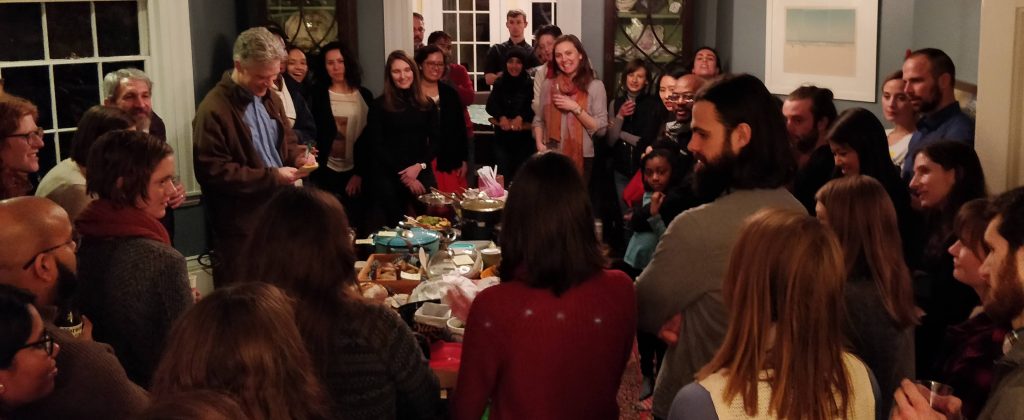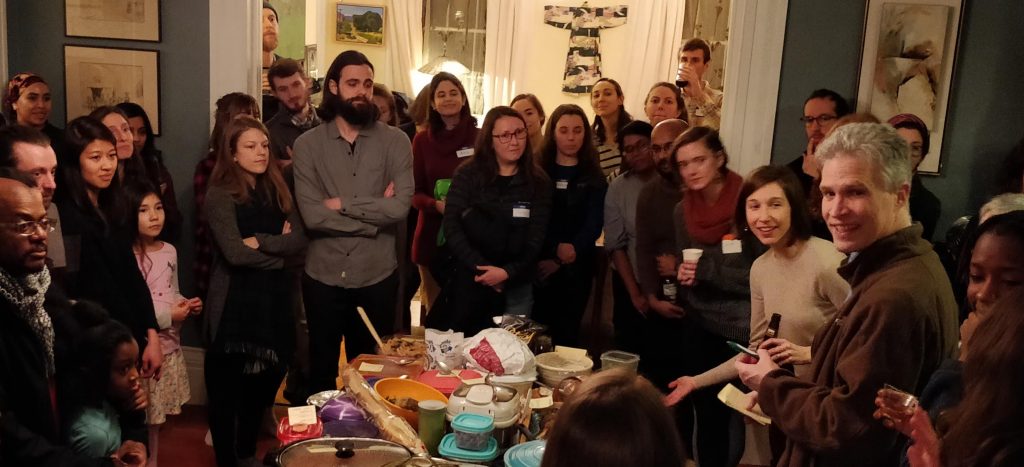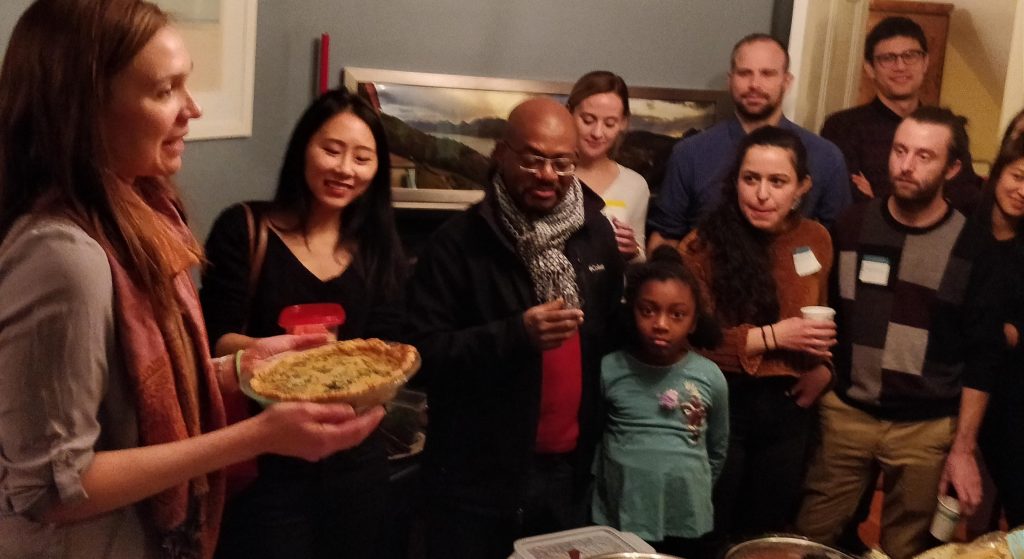Econo’food potluck 2019 — theory meets practice
Our 7th annual econ-of-food class potluck, new and improved: now with an original student recipe!
If the blog post below is too long, don’t read: jump to a small photo album,
or shorter posts from previous years.

as students explain what they brought
We have these dinners just after the class discusses food choice and least-cost diets, meaning the combination of foods that would meet all nutrient needs at the lowest possible expense. For our weekly exercise, students attempt that calculation given current prices in Boston, and compare the result to what very poor people eat in Ethiopia. You can try the exercise yourself using this spreadsheet preloaded with real data, leading to surprising insight about the link between food choice and nutrient needs.
Actual food choices are not least-cost diets: people choose foods for other reasons, and often do not actually meet all nutrient needs. In class we look at global diets using the wonderful Peter Menzel and Faith D’Aluisio “hungry planet” photos, from which one big surprise is how food choices in poorer places get closer to the least-cost source of essential nutrients, as in the corn, beans, oil and fruit diet eaten by refugees in Chad. Most of us eat more of some nutrients than we need, which is good because — as our spreadsheet exercise reveals — we cannot do the math in our heads.
One insight from our least-cost diet exercise is that, even using a spreadsheet preloaded with items from a well-stocked grocery store and precise measures of food composition, hitting nutrient recommendations exactly requires the use of math programming algorithms that were developed during and after WWII by Stigler and Dantzig. Those formulas are still today being used to improve livestock feed, and to inform nutrition assistance for poor people by the USDA, USAID, WFP and others. Most of the time we have to guess at what’s in our food, and choose items that meet our various goals as best we can. The potluck is a chance to celebrate the diverse objectives we actually pursue when choosing what to eat.
To make the potluck fun as well as tasty and nutritious, we invite students to bring dishes that contribute to an overall healthy diet while also pursuing any one of four common aims: (1) convenience, (2) cultural significance, (3) least environmental harm as well as (4) least financial cost. Each student explained their dish, and my esteemed colleagues Nicole Blackstone, Sean Cash, Parke Wilde and Norbert Wilson declared the winners in each category.

Judge Norbert Wilson (far left) was aided by his daughter Amani, and
Nicole Blackstone (at right) gave us a fine introduction to life cycle analysis
As promised, a recipe: Meghan O’Hearn outdid even Google’s chef Anthony Marco with her Savory Pie a la Stigler:

Stigler’s original estimate of a least-cost diet in 1939 contained only enriched wheat flour, evaporated milk, cabbage, spinach and navy beans. Using Excel to compute the exact least-cost diet in Boston now yields a roughly similar list, including a starring role for depression-era canned spinach, and our latest research from the CANDASA project finds the same kind of items in least cost diets around the world.
Here is Meghan’s recipe — revealing how a little butter, some eggs, garlic, olive oil and spices are enough to turn Stigler’s original mush into a fine quiche:
Stigler’s Savory Pie: yields one 9-inch pie
CRUST (you can use an alternate crust recipe if you prefer)
1 cup wheat flour (plus more for rolling)
1/2 tsp salt
1/3 cup shortening
4 tbsp water
FILLING (adapted from: https://www.marthastewart.com/1162977/navy-bean-pie)
1 12-ounce can evaporated milk
1 can navy beans, rinsed and drained
4 tbsp. (half stick) unsalted butter
2 tbsp. wheat flour
4 eggs
100 g spinach (~half a bag of fresh baby spinach)
50 g shredded cabbage
4 cloves of garlic, minced
1/2 white onion
1 sprig of fresh rosemary, minced
1 tsp thyme
salt, pepper to taste
1/2 tbsp olive oil or any cooking oil
INSTRUCTIONS:
PART I: Pie Crust
1. Preheat oven to 400 F.
2. Mix flour and
salt in a large bowl. Cut in shortening with a pastry blender until
mixture is completely blended and appears crumbly.
3. Mix in water, 1
tablespoon at a time, by lightly tossing with a fork. Add only enough
water to form mixture into a ball. The dough will be sticky and tough if
to much water is added, and it will crack and tear when rolled if too
little is added.
4. Roll out dough into circle 1 inch larger than the inverted pie plate.
5.
Fold circle of dough in half, and gently lift. Place into pie plate and
unfold. Either prick the entire surface of dough with a fork, or weight
the bottom of the crust with pie weights while baking. Pie weights can
be uncooked rice, dried beans, small clean pebbles, or small balls sold
as pie weights.
6. Bake for 10 min at 400 F, and then remove weights
and continue to bake for another 6-8 minutes until the crust starts to
get some color. Remove from oven.
PART II: Pie filling and bake
1. Saute onion and garlic in cooking
oil on medium heat. Once translucent, add shredded cabbage. Cook down
cabbage until wilted and add in spinach, rosemary, thyme, and salt and
pepper to taste. Cook until spinach is also wilted– about 4-5 minutes.
2.
In a blender, combine drained/rinsed navy beans, evaporated milk,
butter, flour, eggs and salt and pepper to taste. Blend on
medium-to-high until smooth.
3. Add sauteed vegetables to the the
blender ingredients. Blend on low for 20-30 seconds, or until well
combined. You can also do this part outside of the blender.
4. Pour
filling into the pre-baked pie crust (see above). I ended up with about 1
cup too much filling so I saved that to bake in the future (without a
crust perhaps!!). I also poured off some of the liquid (I think in
hindsight may be better to use less evaporated milk?)
5. Bake in the oven at 350 F for about 60 minutes or until the filling has firmed and started to brown slightly on top.
6. Let rest for at least 15 minutes before serving.
7. Enjoy your Stigler pie masterpiece!
